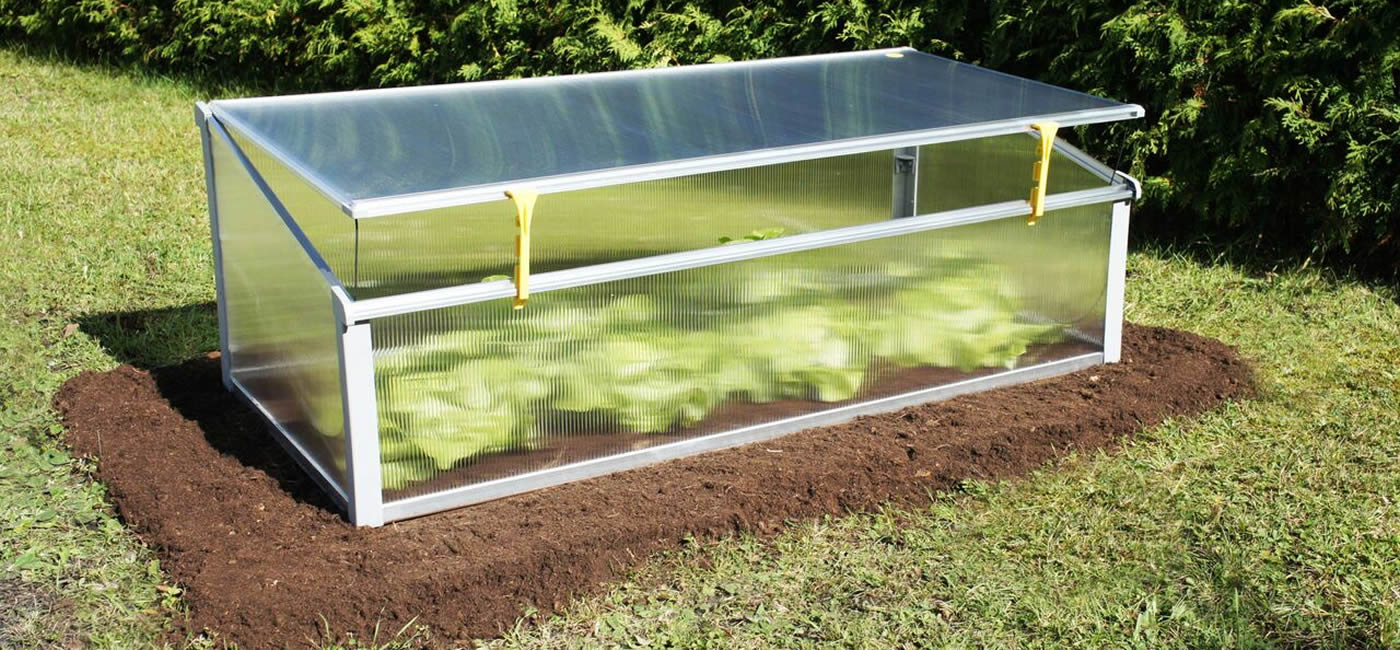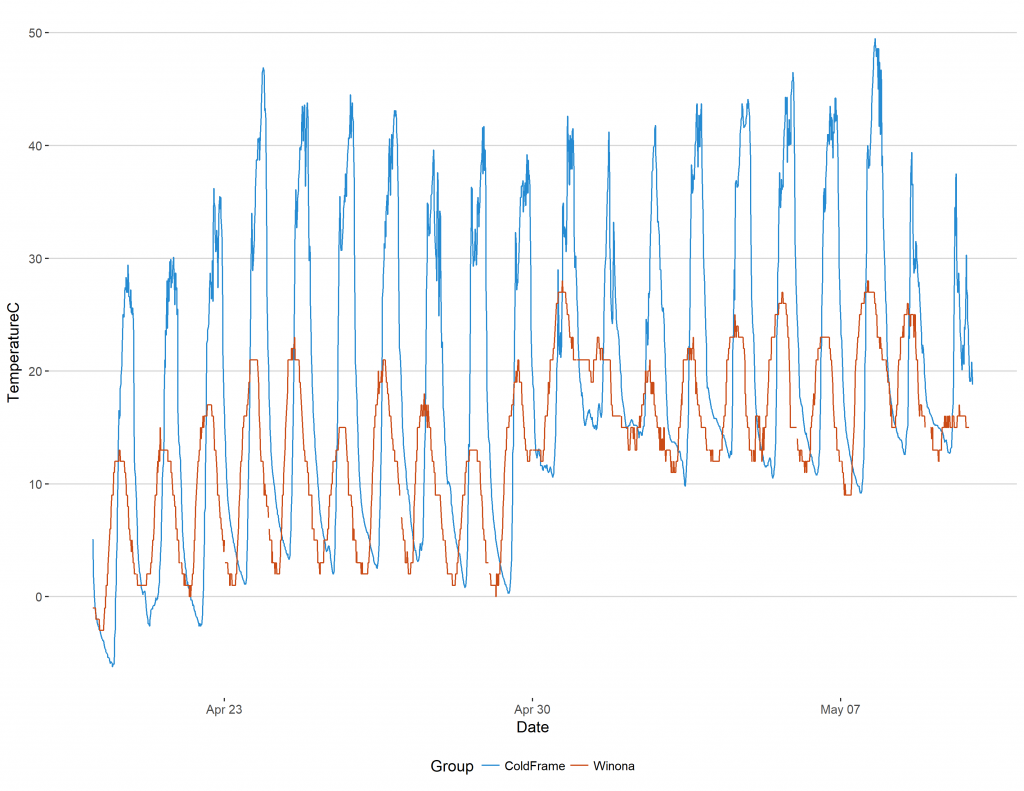
I somehow failed to take and upload any pictures of my cold frame in operation, so here have a stock photo of a similar one. Mine, however, was placed high up on our ‘fortress’ raised bed, exposed to winds.
Cold frames have a long history as an agricultural tool to expand the growing season, in lay terms you would call them a mini greenhouse. Being from Minnesota, I have wanted for years to try one for starting seeds like tomatoes, as well as getting a jump start on lettuce and other leafy greens. I had been intending to build a brick cold frame in the next few years at the end of our ‘fortress’ raised garden, but as a present this year I got a manufactured cold frame.
Qualitative Comparison
I set up the cold frame during a period of warm weather in mid March. I placed it on a section of the raised bed which had thawed the most (there was still a layer of snow on parts of the raised bed). It was an unusually difficult spring. First, it got very cold, notably with the 15″ snow blizzard striking in mid April, then a week after the blizzard it got quite warm, and for the rest of May temperatures in the 80’s F were quite common.
The cold frame suffered a bit under these conditions. Despite my best efforts, the cover was blown off and it spent a chilly week uncovered. The soil would have been warmer if the cold frame had been on all winter, something which I think would improve its use in the future. The cold frame also lacked consistent watering – I had placed an irrigation head inside, but the system was off due to the cold most of the time. However, moisture didn’t seem to be a major difficult, given the enclosed space had lower water loss.
Inside was planted cumin, shallots, tomatoes, and lettuce. As of this weekend, all were larger than their non-cold-frame counterparts, but that isn’t really a fair comparison as the non-cold frame seedings were done a month later in the first week of May. Given the relatively slight difference, on appearance it would seem the cold frame wasn’t really worth the effort in this case. Of course, the only things that clearly benefited were the weeds, which definitely grew much more quickly inside, than outside, of the cold frame.
Quantitative Comparison
I recorded temperature data from inside the cold frame using a TemTop TemLog20 USB recorder. Although it was a bit confusing to figure out the software at first, this device is quite convenient for such tasks.
Unfortunately I haven’t got my own weather station up and running yet, so I had to rely on control weather data from a nearby weather station. As a city kid, I was expecting to be able to quite easily fetch data on a nearby station. However, while nearby weather stations exist and broadcast their data, getting daily and hourly historical data was much more difficult. Ultimately I settled for data from the Climate Data Center for the Winona Municipal Airport. It is 30 miles away, and also being near the Mississippi River has approximately the same climatic conditions as our farm, although not quite as close as I would like.
Winona Data Source: https://www.ncdc.noaa.gov/cdo-web/datatools/lcd
Cold Frame versus Ambient Temperature (at Winona Airport)

Note: mid April the cover blew off, and at that time the inside/outside temps are approximately the same.
What stands out?
- It gets really hot inside the cold frame! It routinely gets up to about 40 C inside the cold frame. Interestingly, this maximum temperature seems to depend more upon the intensity of the sunlight overall, and has less to do with the outside air temperatures. Note this isn’t just an error with the probe heating in direct sun (it was moved several times, and note the period when cover blew off in April, no temp spikes then).
- It gets really cold inside the cold frame at night! Well, maybe not ‘really cold.’ It is still several degrees warmer in minimum temperatures than ambient. For example, the absolute coldest in Winona was -12 C, while here it was -9 C. However, the temperatures are far too cold to do things such as start tomatoes.
Zoom-in on Late April/Early May

Here, it was almost always sunny, and nothing unexpected (like blowing away covers) happened. Note that the cold frame data actually is in UTC, so there’s an offset in time (by 5 hours) due to that. However I left that offset in the graph because I felt it made comparing the lines’ peaks easier. From this graph, one facet stands out:
- Maximum cold frame temperature is largely independent of ambient temperature. See how despite the jump in ambient temperatures in the first week of May, the cold frame’s maximum temperatures are nearly the same as earlier in April.
We again see the high spike due to the sunlight, and again see that quickly lost with the cold frame down to normal ambient temperatures at night.
Conclusions
I think one thing really stands out from this investigation:
Cold frames really need insulation and placement out of the wind to be effective!
The cold frame was successful at trapping large amounts of sun heat, but it was not so effective at keeping that heat for any length of time. This seems to explain the lack of major growth from my vegetables inside, and the more major growth of weeds inside. Tomatoes, for example, won’t sprout if they are continually exposed to such cold temperatures. Certain Minnesota weeds, however, will gladly sprout with lots of heat, while not minding the cold night temperatures nearly so much.
This is fantastic! It means I can probably use my cold frame for benefit in the future, I will just use it differently. My current thought is to place it down (still south-facing in full sun) at the bottom of the ‘fortress’ garden, and surround it with hay bales. Before looking at the data, I had assumed my cold frame was simply a waste, not warming up at all, but that is clearly not the case. Score another for data and science.
Data and Code
https://github.com/winedarksea/ColdFrameTemperature

